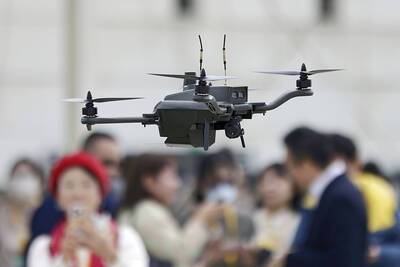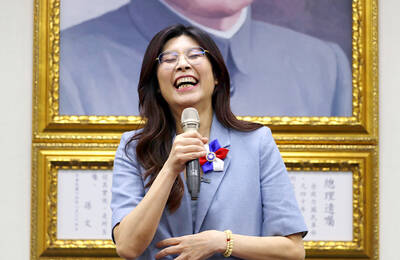Typhoon Nanmadol last night made landfall in southwestern Japan, as authorities urged millions of people to take shelter from the storm’s winds and torrential rain.
The storm officially made landfall at about 7pm as its eyewall arrived near Kagoshima city, the Japan Meteorological Agency said.
It was packing gusts of up to 234kph and had already dumped up to 500mm of rain in less than 24 hours on parts of southwestern Kyushu.

Photo: AP
At least 20,000 people were spending the night in shelters in Kyushu’s Kagoshima and Miyazaki prefectures, where the agency issued a rare “special warning” — an alert that is issued only when conditions are forecast that are expected once in several decades.
National broadcaster NHK, which collates information from local authorities, said more than 7 million people had been told to move to shelters or take refuge in sturdy buildings to ride out the storm.
The evacuation warnings are not mandatory, and authorities have at times struggled to convince people to move to shelters before extreme weather.
They sought to drive home their concerns about the weather system throughout the weekend.
“Please stay away from dangerous places, and please evacuate if you feel even the slightest hint of danger,” Japanese Prime Minister Fumio Kishida wrote on Twitter after convening a government meeting on the storm. “It will be dangerous to evacuate at night. Please move to safety while it’s still light outside.”
The agency has warned the region could face “unprecedented” danger from high winds, storm surges and torrential rain, and called the storm “very dangerous.”
“Areas affected by the storm are seeing the sort of rain that has never been experienced before,” Hiro Kato, the head of the Weather Monitoring and Warning Center, told reporters. “Especially in areas under landslide warnings, it is extremely probable that some kinds of landslides are already happening.”
He urged “maximum caution even in areas where disasters do not usually happen.”
By yesterday evening, utility companies said nearly 200,000 homes across the region were without power.
Trains, flights and ferry services were canceled until the passage of the storm, and even some convenience stores — generally open all hours and considered a lifeline in disasters — were shutting their doors.
In Taipei, the Central Weather Bureau on Saturday said the typhoon would not affect Taiwan other than bringing brief localized rain to some regions.
Northerly winds would bring moisture from Nanmadol’s periphery and increase cloud formation, bringing brief showers to northern, eastern and southeastern Taiwan, as well as localized downpours to eastern and southeastern regions, it said.
It would mostly be sunny to cloudy in other regions, but eastern Taiwan and mountainous areas might see brief, localized thundershowers, and central and southern Taiwan might see brief showers, it added.
Additional reporting by CNA

The combined effect of the monsoon, the outer rim of Typhoon Fengshen and a low-pressure system is expected to bring significant rainfall this week to various parts of the nation, the Central Weather Administration (CWA) said. The heaviest rain is expected to occur today and tomorrow, with torrential rain expected in Keelung’s north coast, Yilan and the mountainous regions of Taipei and New Taipei City, the CWA said. Rivers could rise rapidly, and residents should stay away from riverbanks and avoid going to the mountains or engaging in water activities, it said. Scattered showers are expected today in central and

COOPERATION: Taiwan is aligning closely with US strategic objectives on various matters, including China’s rare earths restrictions, the Ministry of Foreign Affairs said Taiwan could deal with China’s tightened export controls on rare earth metals by turning to “urban mining,” a researcher said yesterday. Rare earth metals, which are used in semiconductors and other electronic components, could be recovered from industrial or electronic waste to reduce reliance on imports, National Cheng Kung University Department of Resources Engineering professor Lee Cheng-han (李政翰) said. Despite their name, rare earth elements are not actually rare — their abundance in the Earth’s crust is relatively high, but they are dispersed, making extraction and refining energy-intensive and environmentally damaging, he said, adding that many countries have opted to

SUPPLY CHAIN: Taiwan’s advantages in the drone industry include rapid production capacity that is independent of Chinese-made parts, the economic ministry said The Executive Yuan yesterday approved plans to invest NT$44.2 billion (US$1.44 billion) into domestic production of uncrewed aerial vehicles over the next six years, bringing Taiwan’s output value to more than NT$40 billion by 2030 and making the nation Asia’s democratic hub for the drone supply chain. The proposed budget has NT$33.8 billion in new allocations and NT$10.43 billion in existing funds, the Ministry of Economic Affairs said. Under the new development program, the public sector would purchase nearly 100,000 drones, of which 50,898 would be for civil and government use, while 48,750 would be for national defense, it said. The Ministry of

UNITED: The other candidates congratulated Cheng on her win, saying they hoped the new chair could bring the party to victory in the elections next year and in 2028 Former Chinese Nationalist Party (KMT) lawmaker Cheng Li-wun (鄭麗文) yesterday won the party’s chair election with 65,122 votes, or 50.15 percent of the votes. It was the first time Cheng, 55, ran for the top KMT post, and she is the second woman to hold the post of chair, following Hung Hsiu-chu (洪秀柱), who served from 2016 to 2017. Cheng is to succeed incumbent Eric Chu (朱立倫) on Nov. 1 for a four-year term. Cheng said she has spoken with the other five candidates and pledged to maintain party unity, adding that the party would aim to win the elections next year and